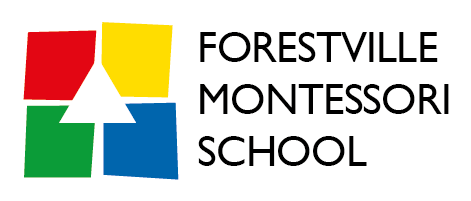Montessori Matters
Mathematics the Montessori Way
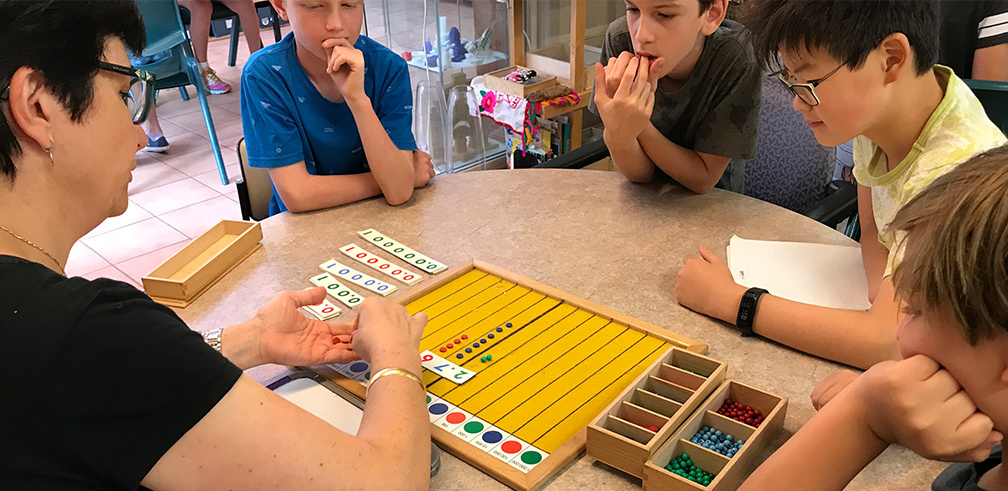
Anthony Milano, Deputy Principal & Head of Montessori Teaching and Learning

Dr. Montessori (1912) at the turn of the century remarked:
“This system in which a child is constantly moving objects with his hands and actively exercising his senses, also takes into account a child’s special aptitude for mathematics. When they leave the material, the children very easily reach the point where they wish to write out the operation. They thus carry out an abstract mental operation and acquire a kind of natural and spontaneous inclination for mental calculations.”
For many children and adults, the thought of having to do mathematics or computations brings on a fear. Why do we manifest this fear about mathematics? Was it because we were forced to learn and recite facts, figures and rules in order to be good at math. For many, mathematics at school was a dry, boring subject. Typically, the teacher demonstrated a set of procedures that can be used to solve a particular kind of problem. A similar problem is then introduced for the class to solve together. Then, the students get a number of exercises from the teacher, a textbook or worksheet to practice on their own. When we are forced to learn this way we often have no real understanding or the ability to put these skills to use in everyday life.
In conventional settings, we are still in some ways limiting what children can do in Mathematics. In our own state syllabus for Mathematics we break it down into stages, defining what you can and can’t do. At the school level, it is broken down even further by age, grade level and ability. Working collaboratively, creatively and with concrete materials is hinted at but with standardised testing driving curriculum many forgo the concrete in favour of getting through the narrow focus of textbook activities and worksheets to teach abstract ideas. Many children are asked to understand complex reasoning when they are just not ready. Worksheets, teacher set examples and text books don’t initiate the creativity to explore the wonderful nature of mathematics in our lives or in nature.
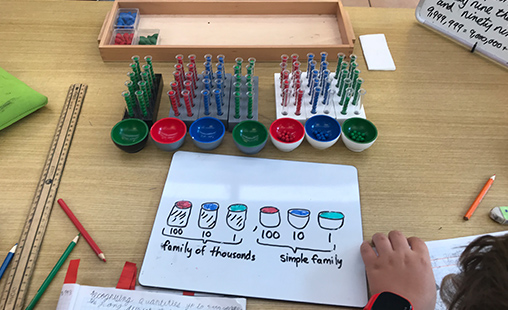 Understanding place value by building and naming quantities up to 9,999,999 and beyond.Learning
comes much more easily when children work with concrete materials that show what is taking place in a given mathematical process.
In our Montessori classrooms children use hands-on learning materials that make abstract concepts clear and concrete. They see
and explore what is going on. This approach to teaching mathematics based on the research of Dr. Maria Montessori, offers a clear
and logical strategy for assisting students to understand and develop a sound foundation in mathematics and geometry.
Understanding place value by building and naming quantities up to 9,999,999 and beyond.Learning
comes much more easily when children work with concrete materials that show what is taking place in a given mathematical process.
In our Montessori classrooms children use hands-on learning materials that make abstract concepts clear and concrete. They see
and explore what is going on. This approach to teaching mathematics based on the research of Dr. Maria Montessori, offers a clear
and logical strategy for assisting students to understand and develop a sound foundation in mathematics and geometry.
Historically, the complete array of Montessori mathematics materials and exercises were first described and published in Spain in 1934 in two volumes called Psicoaritmetica and Psicogeometria. Feez (2010) states,
“The pedagogy is designed to match the special psychology of children, first under six, who explore with their senses and think with their hands (the absorbent mind), and then later, further along the path to mathematical culture, children over six, who think with their imagination (the reasoning mind), and who are moving along the passage to abstraction. The pedagogy has the potential to change children’s consciousness by changing the way they pay attention to and what they are able to perceive. It draws their attention to distinctions, patterns and relationships they would not otherwise be able to see in ways that are meaningful in the field of mathematics as it is understood in the children’s culture.”
As an example, consider how Montessori presents the basic concepts of the decimal system to children. Units are represented by single golden beads, ten is represented by ten unit beads strung together. Hundreds are squares made up of ten ten-bars, and thousands are cubes made up of ten hundred-squares. Using these concrete materials, even very young children can build and work with great numbers. “Please bring me eight thousands, four hundreds, six tens and three units.” Through weight, colour, size and real quantity the children internalise a clear image of how mathematical processes work.
In our Infant Community and in the Children’s House the sensorial, cultural and practical life activities give the child the language to describe their world. Experiences develop a language around order, precision, size, quantity, weight, sequence, and shape. In the Montessori Infant Community, for example, “children set their own place at a table. The shape of each item of cutlery, as well as of a plate and a cup, is embroidered onto the place mat. Infants set their place by matching the objects to the embroidered outlines.” The same pattern is used throughout the Montessori maths curriculum. Children experience quantities in concrete form first, then they learn the symbols and finally they match the symbol to quantity. From this foundation, all of the operations in mathematics become clear and concrete. Montessori (1949) states,
“While Babies and toddlers effortlessly and unconsciously absorb myriad impressions from their environment, from about the age of three the child is always playing with something. This means that he is working out, and making conscious something that his unconscious mind has early absorbed … he does it through his hands, by experience, first in play, then through work.”
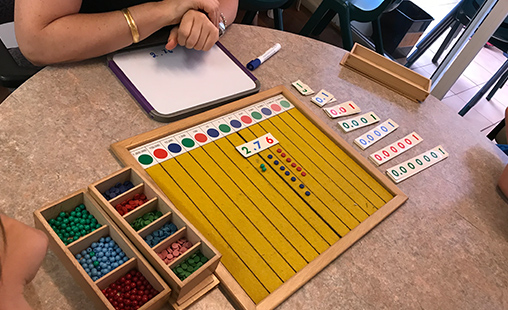 The Yellow Board: working with decimals.The
Montessori math curriculum for 6 to 12 year olds includes the study of the fundamentals of algebra, geometry, logic, and statistics
along with the principles of arithmetic. This study continues over the years, weaving together subjects that conventional schools
normally ignore until the secondary years. In operations concerned with measurement, geometry shows students how to perform their
calculations. In operations concerned with numbers, algebra gives a system of still more abstract symbols by means of which more
complicated relationships can be understood. The calculations of area and volume, of squares and square roots are examples when
algebra, arithmetic, and geometry are all involved. For our students, arithmetic, algebra, and plane and solid geometry have never
been taught as arbitrarily separated. Four and five year old Montessori children can name geometric shapes that most adults wouldn’t
recognise.
The Yellow Board: working with decimals.The
Montessori math curriculum for 6 to 12 year olds includes the study of the fundamentals of algebra, geometry, logic, and statistics
along with the principles of arithmetic. This study continues over the years, weaving together subjects that conventional schools
normally ignore until the secondary years. In operations concerned with measurement, geometry shows students how to perform their
calculations. In operations concerned with numbers, algebra gives a system of still more abstract symbols by means of which more
complicated relationships can be understood. The calculations of area and volume, of squares and square roots are examples when
algebra, arithmetic, and geometry are all involved. For our students, arithmetic, algebra, and plane and solid geometry have never
been taught as arbitrarily separated. Four and five year old Montessori children can name geometric shapes that most adults wouldn’t
recognise.
Primary students continue to gain hands-on experiences by applying mathematics to a wide range of projects, activities and challenges. Real tasks, such as graphing the daily temperature and working out the average for each month, or adjusting the quantities in a recipe to feed all the children in the class bring mathematics to life. Using geometry, children can determine the height of a tree or measure the dimensions of a building. They can prepare scale drawings, calculate area and volume, and construct three-dimensional geometric models.
Most math lessons in conventional settings are focused on fixing our mind on an abstract idea. The classic methodology in learning the multiplication tables is to say them out loud “2 x 2 = 4, 2 x 3 = 6” over and over, or to write them out over and over, hoping that they will stick somewhere in the brain. In fact, Scoppola (2010) tells us, “this is wrong, completely wrong.” For many of us this deep memorisation never happens and we resort to other measures to compensate for the missing concrete experience.
Montessori (2011) tells us clearly in Psycogeometry:
“It not about fixing our minds on an idea but about handling an object and examining it with our senses, moving it continuously … The mind has come into contact and lingers on the object in the periphery taking in everything that the object can give us. The hand touch is the evidence and the mind discovers the secret.”
In the lower primary, children see this when they begin to layout the multiplication table from 1 to 10. The manipulation of bead bars presents the child with a variety of sensations and manipulations in order to deeply memorise the multiplication tables. What comes into play: object, weight, colour, an attachment of language and symbol to quantity, manipulation to form geometric representations of products.
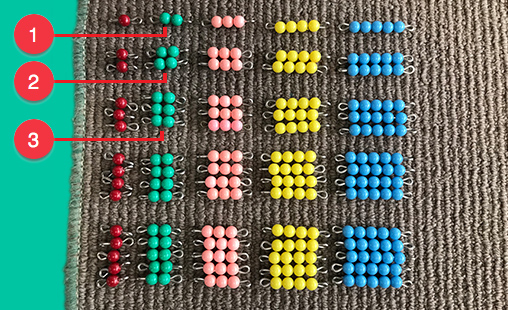 Building the Decanomial: understanding multiplication tables, multiples, factors and the power of numbers.
Building the Decanomial: understanding multiplication tables, multiples, factors and the power of numbers.
In the photo above, the child is beginning to build the 2 times tables:
- The green bead bar representing two is placed first with the language: “2 bar taken 1 times equals 2”. It creates a line.
- “2 bar taken two times equals four”. The child places two of the two bars down and has created a square. This is the indirect preparation for algebra - the multiples of numbers, factors and the power of numbers. Here the square is 22 = 4.
- Next, “2 bar take 3 times equals 6”. The child has created a rectangle.
What is it that makes Montessori mathematics ‘magical math’?
In the Montessori mathematics curriculum, we give children the opportunity for creating rich hand and mind connections. The magic happens when children are introduced to concepts in the following sequence:
- Materialised quantity
- Manipulable symbol
- Labelling quantity with symbol
- Exploring different ways of working with concrete quantities and manipulable symbols
- Passage to abstraction
- Transfer of the concept to applications in the wider environment.
The magic remains when long after a Montessori math lesson, children can apply their learning to new situations, there is joy in learning complex mathematical concepts and an intrinsic desire to learn more.
References
This article is an adaptation and expands on the original concepts presented in:
- Feez; Susan. “Montessori Mathematics”, Montessori and Early Childhood. Sage, London 2010
- Helfrich; M. Shannon. “The Mathematical Mind”. The NAMTA Journal Vol. 35 #2 2010
- Montessori; Maria. “Psychogeometry”. Montessori-Pierson, Amsterdam 2011
- Montessori; Maria. “The Montessori Method”. Schocken, New York 1964
- Scoppola; Benedetto. “Montessori Mathematics: A Neuroscientific Perspective”. The NAMTA Journal Vol. 35 #2 2010
